Comparative Analysis: KM Implementations of Infosys and RBNZ
VerifiedAdded on 2020/05/16
|10
|2046
|142
Report
AI Summary
This report provides a comprehensive comparison of the knowledge management (KM) implementations at Infosys and the Reserve Bank of New Zealand (RBNZ). It begins with an introduction to KM, emphasizing its importance in organizational success. The report then delves into detailed descriptions of Infosys and RBNZ, outlining their respective knowledge types (explicit and tacit), KM objectives, organizational objectives, and competitive advantages within the knowledge economy. A comparative analysis highlights the differences in their KM approaches, including the PSPD model used by Infosys and the commitment to a more organic framework by RBNZ. The report further examines the success factors and lessons learned from each implementation, such as Infosys's formal KM structure and RBNZ's focus on cultural transformation. Finally, the report offers recommendations for KM improvement for both organizations, suggesting a resource-based view for Infosys and a best-practice approach for RBNZ, concluding with the significance of effective KM for enhancing productivity and capitalizing on intellectual assets.
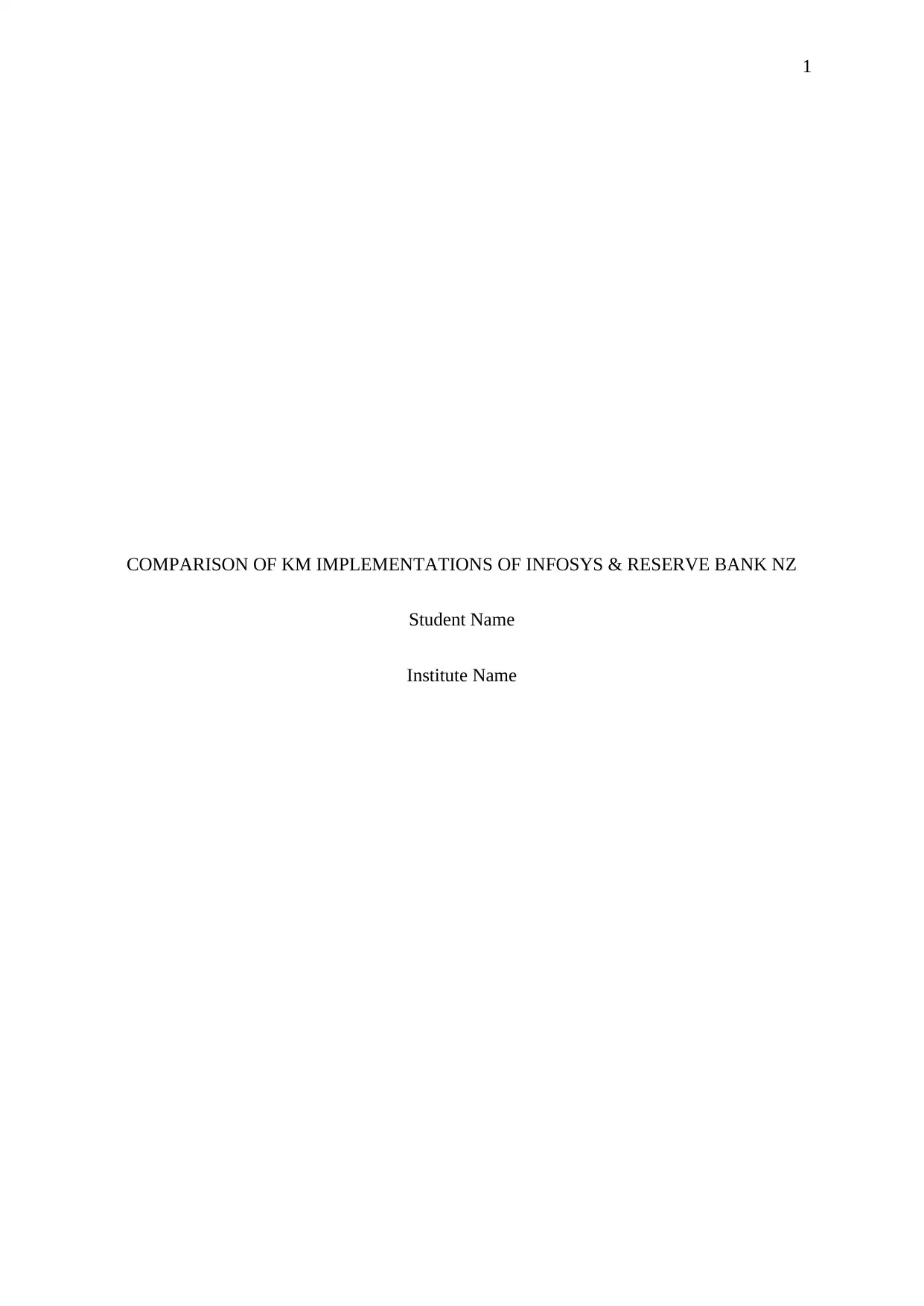
1
COMPARISON OF KM IMPLEMENTATIONS OF INFOSYS & RESERVE BANK NZ
Student Name
Institute Name
COMPARISON OF KM IMPLEMENTATIONS OF INFOSYS & RESERVE BANK NZ
Student Name
Institute Name
Paraphrase This Document
Need a fresh take? Get an instant paraphrase of this document with our AI Paraphraser
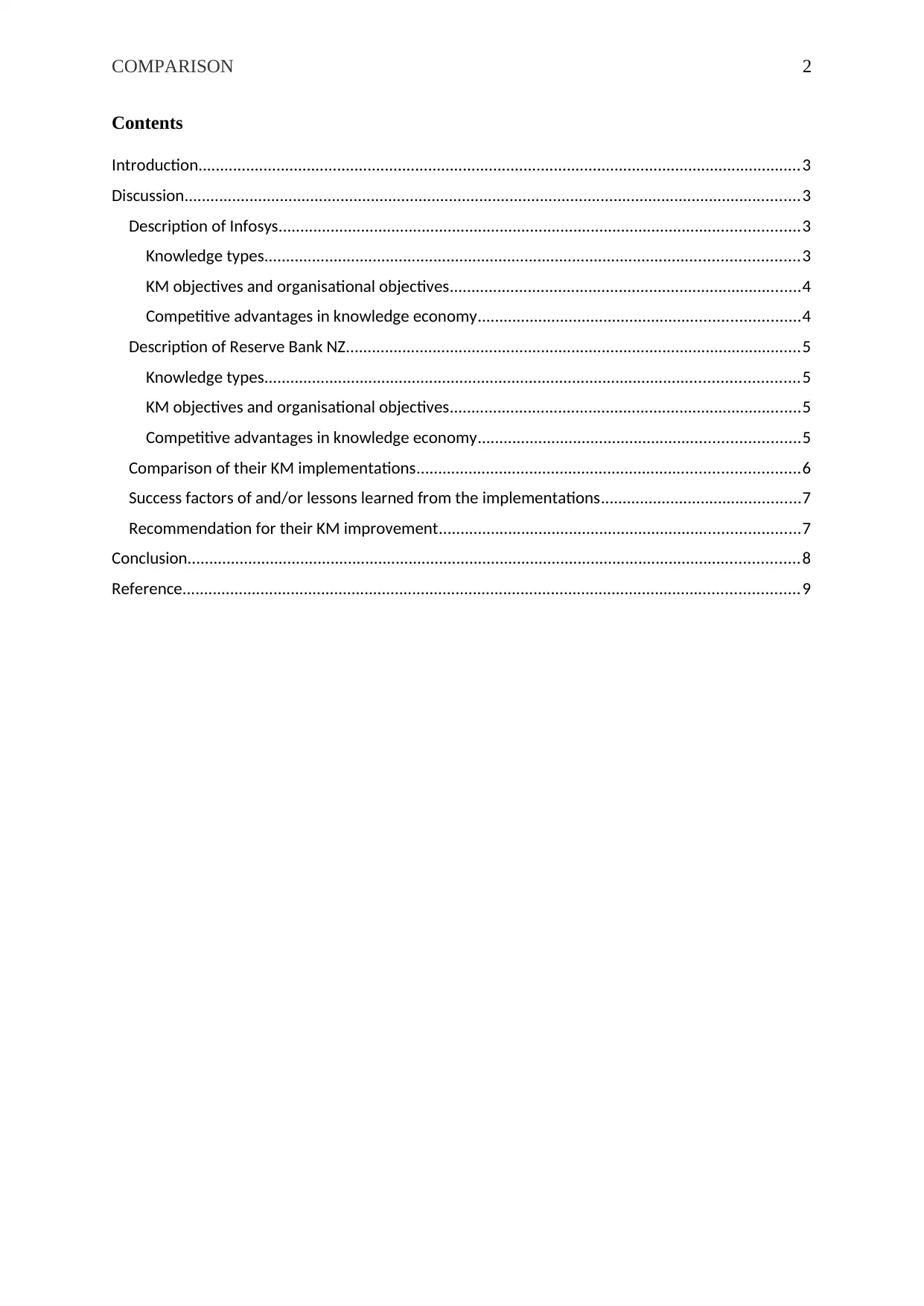
COMPARISON 2
Contents
Introduction...........................................................................................................................................3
Discussion..............................................................................................................................................3
Description of Infosys........................................................................................................................3
Knowledge types...........................................................................................................................3
KM objectives and organisational objectives.................................................................................4
Competitive advantages in knowledge economy..........................................................................4
Description of Reserve Bank NZ.........................................................................................................5
Knowledge types...........................................................................................................................5
KM objectives and organisational objectives.................................................................................5
Competitive advantages in knowledge economy..........................................................................5
Comparison of their KM implementations........................................................................................6
Success factors of and/or lessons learned from the implementations..............................................7
Recommendation for their KM improvement...................................................................................7
Conclusion.............................................................................................................................................8
Reference..............................................................................................................................................9
Contents
Introduction...........................................................................................................................................3
Discussion..............................................................................................................................................3
Description of Infosys........................................................................................................................3
Knowledge types...........................................................................................................................3
KM objectives and organisational objectives.................................................................................4
Competitive advantages in knowledge economy..........................................................................4
Description of Reserve Bank NZ.........................................................................................................5
Knowledge types...........................................................................................................................5
KM objectives and organisational objectives.................................................................................5
Competitive advantages in knowledge economy..........................................................................5
Comparison of their KM implementations........................................................................................6
Success factors of and/or lessons learned from the implementations..............................................7
Recommendation for their KM improvement...................................................................................7
Conclusion.............................................................................................................................................8
Reference..............................................................................................................................................9
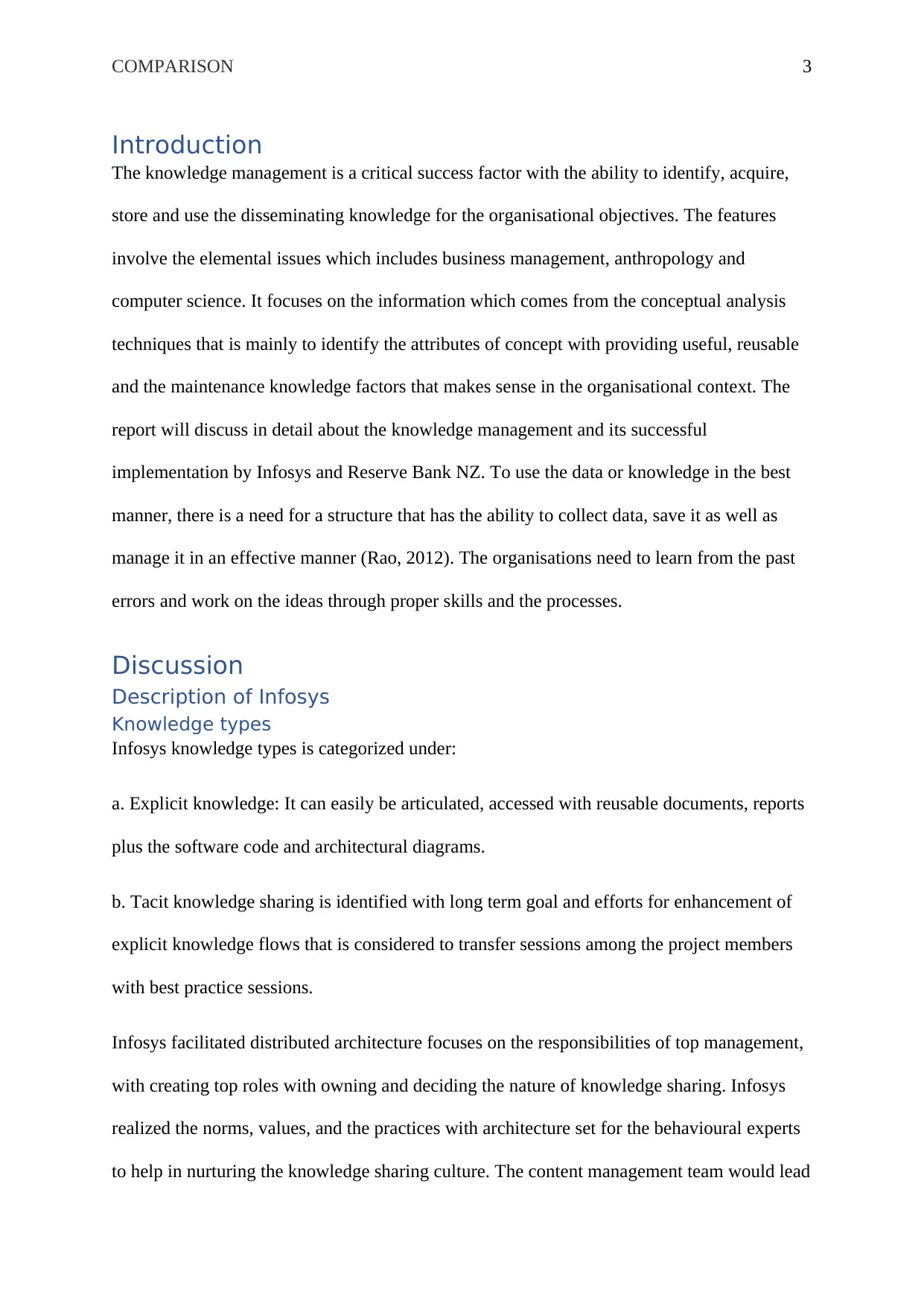
COMPARISON 3
Introduction
The knowledge management is a critical success factor with the ability to identify, acquire,
store and use the disseminating knowledge for the organisational objectives. The features
involve the elemental issues which includes business management, anthropology and
computer science. It focuses on the information which comes from the conceptual analysis
techniques that is mainly to identify the attributes of concept with providing useful, reusable
and the maintenance knowledge factors that makes sense in the organisational context. The
report will discuss in detail about the knowledge management and its successful
implementation by Infosys and Reserve Bank NZ. To use the data or knowledge in the best
manner, there is a need for a structure that has the ability to collect data, save it as well as
manage it in an effective manner (Rao, 2012). The organisations need to learn from the past
errors and work on the ideas through proper skills and the processes.
Discussion
Description of Infosys
Knowledge types
Infosys knowledge types is categorized under:
a. Explicit knowledge: It can easily be articulated, accessed with reusable documents, reports
plus the software code and architectural diagrams.
b. Tacit knowledge sharing is identified with long term goal and efforts for enhancement of
explicit knowledge flows that is considered to transfer sessions among the project members
with best practice sessions.
Infosys facilitated distributed architecture focuses on the responsibilities of top management,
with creating top roles with owning and deciding the nature of knowledge sharing. Infosys
realized the norms, values, and the practices with architecture set for the behavioural experts
to help in nurturing the knowledge sharing culture. The content management team would lead
Introduction
The knowledge management is a critical success factor with the ability to identify, acquire,
store and use the disseminating knowledge for the organisational objectives. The features
involve the elemental issues which includes business management, anthropology and
computer science. It focuses on the information which comes from the conceptual analysis
techniques that is mainly to identify the attributes of concept with providing useful, reusable
and the maintenance knowledge factors that makes sense in the organisational context. The
report will discuss in detail about the knowledge management and its successful
implementation by Infosys and Reserve Bank NZ. To use the data or knowledge in the best
manner, there is a need for a structure that has the ability to collect data, save it as well as
manage it in an effective manner (Rao, 2012). The organisations need to learn from the past
errors and work on the ideas through proper skills and the processes.
Discussion
Description of Infosys
Knowledge types
Infosys knowledge types is categorized under:
a. Explicit knowledge: It can easily be articulated, accessed with reusable documents, reports
plus the software code and architectural diagrams.
b. Tacit knowledge sharing is identified with long term goal and efforts for enhancement of
explicit knowledge flows that is considered to transfer sessions among the project members
with best practice sessions.
Infosys facilitated distributed architecture focuses on the responsibilities of top management,
with creating top roles with owning and deciding the nature of knowledge sharing. Infosys
realized the norms, values, and the practices with architecture set for the behavioural experts
to help in nurturing the knowledge sharing culture. The content management team would lead
⊘ This is a preview!⊘
Do you want full access?
Subscribe today to unlock all pages.

Trusted by 1+ million students worldwide
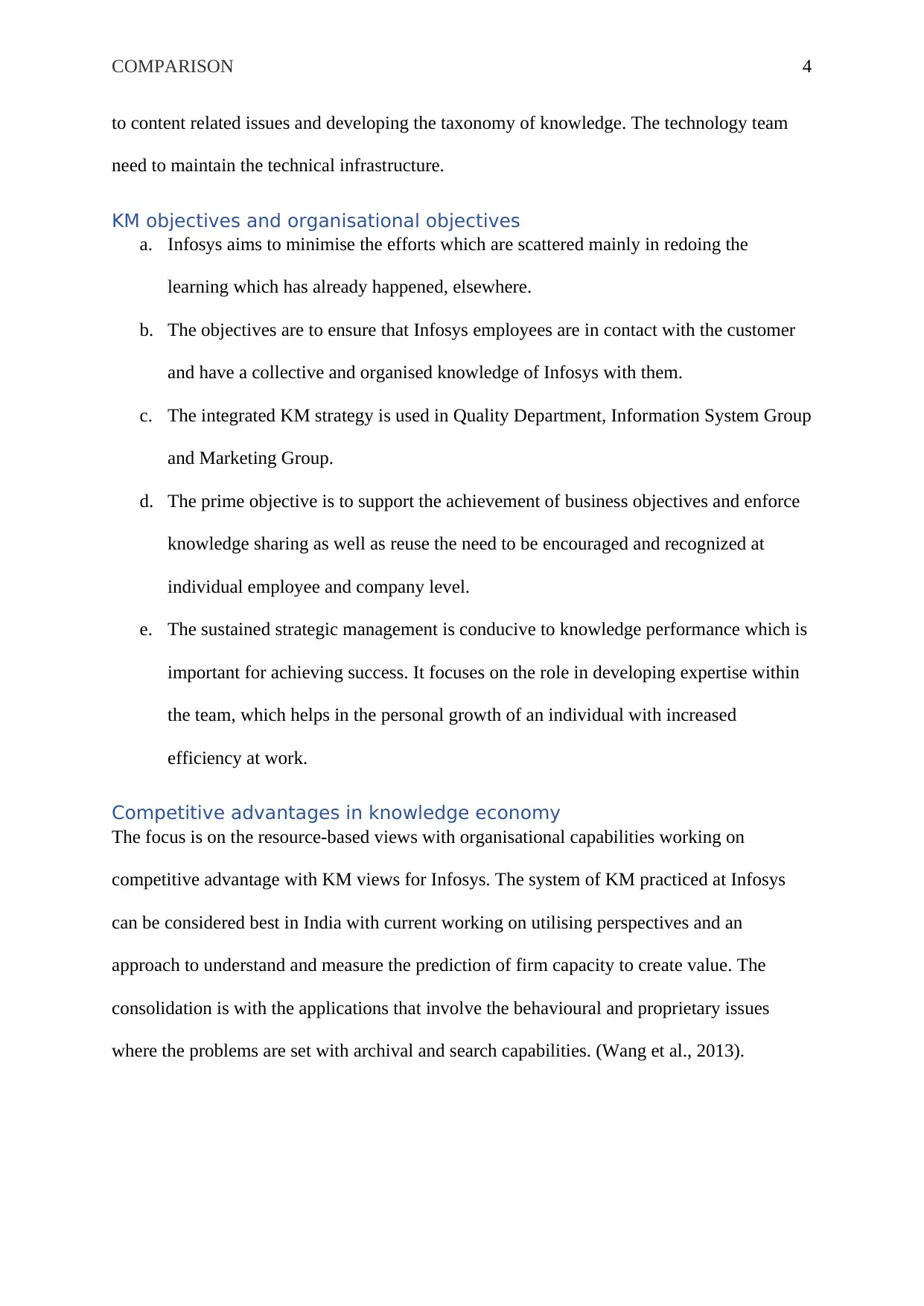
COMPARISON 4
to content related issues and developing the taxonomy of knowledge. The technology team
need to maintain the technical infrastructure.
KM objectives and organisational objectives
a. Infosys aims to minimise the efforts which are scattered mainly in redoing the
learning which has already happened, elsewhere.
b. The objectives are to ensure that Infosys employees are in contact with the customer
and have a collective and organised knowledge of Infosys with them.
c. The integrated KM strategy is used in Quality Department, Information System Group
and Marketing Group.
d. The prime objective is to support the achievement of business objectives and enforce
knowledge sharing as well as reuse the need to be encouraged and recognized at
individual employee and company level.
e. The sustained strategic management is conducive to knowledge performance which is
important for achieving success. It focuses on the role in developing expertise within
the team, which helps in the personal growth of an individual with increased
efficiency at work.
Competitive advantages in knowledge economy
The focus is on the resource-based views with organisational capabilities working on
competitive advantage with KM views for Infosys. The system of KM practiced at Infosys
can be considered best in India with current working on utilising perspectives and an
approach to understand and measure the prediction of firm capacity to create value. The
consolidation is with the applications that involve the behavioural and proprietary issues
where the problems are set with archival and search capabilities. (Wang et al., 2013).
to content related issues and developing the taxonomy of knowledge. The technology team
need to maintain the technical infrastructure.
KM objectives and organisational objectives
a. Infosys aims to minimise the efforts which are scattered mainly in redoing the
learning which has already happened, elsewhere.
b. The objectives are to ensure that Infosys employees are in contact with the customer
and have a collective and organised knowledge of Infosys with them.
c. The integrated KM strategy is used in Quality Department, Information System Group
and Marketing Group.
d. The prime objective is to support the achievement of business objectives and enforce
knowledge sharing as well as reuse the need to be encouraged and recognized at
individual employee and company level.
e. The sustained strategic management is conducive to knowledge performance which is
important for achieving success. It focuses on the role in developing expertise within
the team, which helps in the personal growth of an individual with increased
efficiency at work.
Competitive advantages in knowledge economy
The focus is on the resource-based views with organisational capabilities working on
competitive advantage with KM views for Infosys. The system of KM practiced at Infosys
can be considered best in India with current working on utilising perspectives and an
approach to understand and measure the prediction of firm capacity to create value. The
consolidation is with the applications that involve the behavioural and proprietary issues
where the problems are set with archival and search capabilities. (Wang et al., 2013).
Paraphrase This Document
Need a fresh take? Get an instant paraphrase of this document with our AI Paraphraser
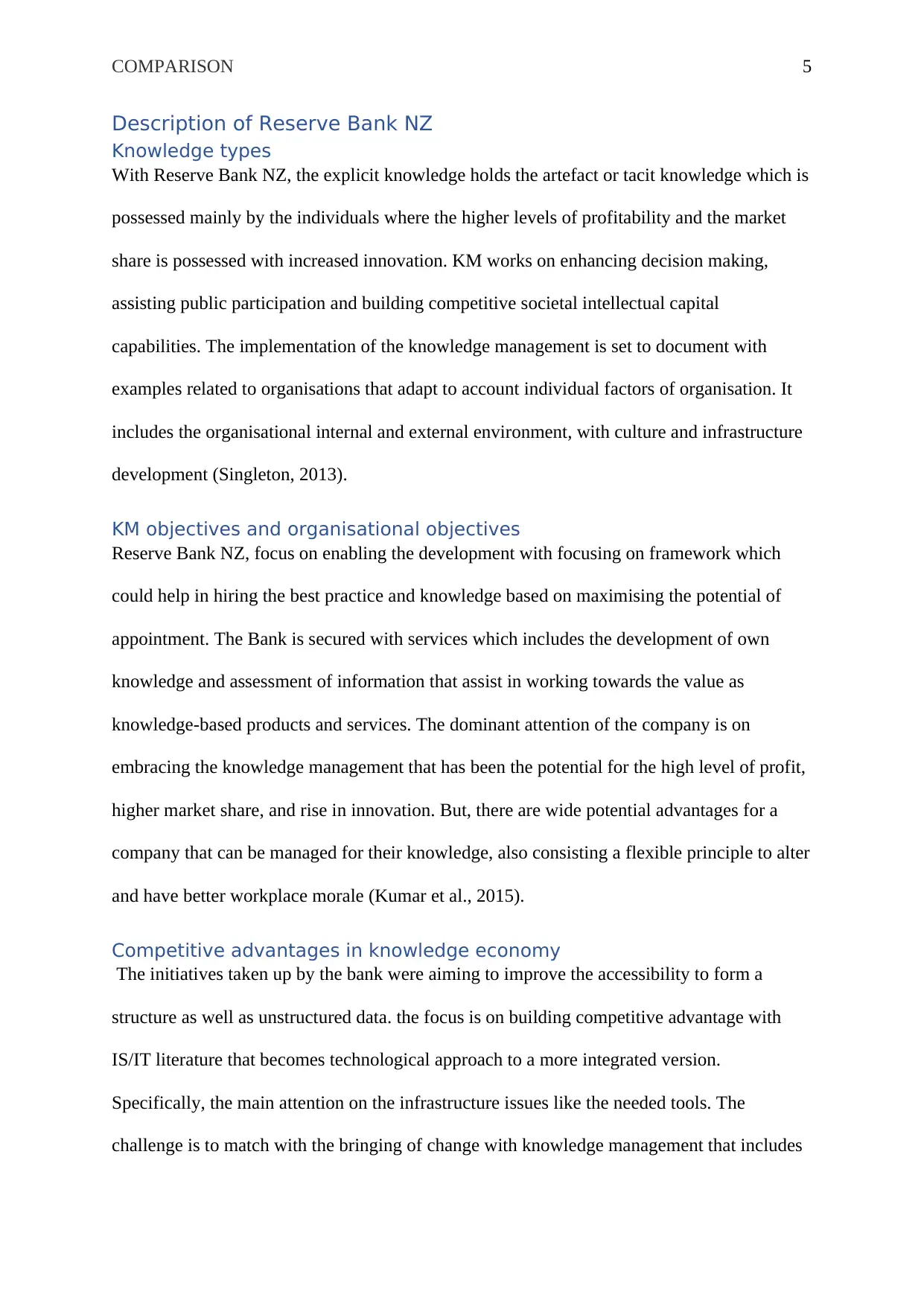
COMPARISON 5
Description of Reserve Bank NZ
Knowledge types
With Reserve Bank NZ, the explicit knowledge holds the artefact or tacit knowledge which is
possessed mainly by the individuals where the higher levels of profitability and the market
share is possessed with increased innovation. KM works on enhancing decision making,
assisting public participation and building competitive societal intellectual capital
capabilities. The implementation of the knowledge management is set to document with
examples related to organisations that adapt to account individual factors of organisation. It
includes the organisational internal and external environment, with culture and infrastructure
development (Singleton, 2013).
KM objectives and organisational objectives
Reserve Bank NZ, focus on enabling the development with focusing on framework which
could help in hiring the best practice and knowledge based on maximising the potential of
appointment. The Bank is secured with services which includes the development of own
knowledge and assessment of information that assist in working towards the value as
knowledge-based products and services. The dominant attention of the company is on
embracing the knowledge management that has been the potential for the high level of profit,
higher market share, and rise in innovation. But, there are wide potential advantages for a
company that can be managed for their knowledge, also consisting a flexible principle to alter
and have better workplace morale (Kumar et al., 2015).
Competitive advantages in knowledge economy
The initiatives taken up by the bank were aiming to improve the accessibility to form a
structure as well as unstructured data. the focus is on building competitive advantage with
IS/IT literature that becomes technological approach to a more integrated version.
Specifically, the main attention on the infrastructure issues like the needed tools. The
challenge is to match with the bringing of change with knowledge management that includes
Description of Reserve Bank NZ
Knowledge types
With Reserve Bank NZ, the explicit knowledge holds the artefact or tacit knowledge which is
possessed mainly by the individuals where the higher levels of profitability and the market
share is possessed with increased innovation. KM works on enhancing decision making,
assisting public participation and building competitive societal intellectual capital
capabilities. The implementation of the knowledge management is set to document with
examples related to organisations that adapt to account individual factors of organisation. It
includes the organisational internal and external environment, with culture and infrastructure
development (Singleton, 2013).
KM objectives and organisational objectives
Reserve Bank NZ, focus on enabling the development with focusing on framework which
could help in hiring the best practice and knowledge based on maximising the potential of
appointment. The Bank is secured with services which includes the development of own
knowledge and assessment of information that assist in working towards the value as
knowledge-based products and services. The dominant attention of the company is on
embracing the knowledge management that has been the potential for the high level of profit,
higher market share, and rise in innovation. But, there are wide potential advantages for a
company that can be managed for their knowledge, also consisting a flexible principle to alter
and have better workplace morale (Kumar et al., 2015).
Competitive advantages in knowledge economy
The initiatives taken up by the bank were aiming to improve the accessibility to form a
structure as well as unstructured data. the focus is on building competitive advantage with
IS/IT literature that becomes technological approach to a more integrated version.
Specifically, the main attention on the infrastructure issues like the needed tools. The
challenge is to match with the bringing of change with knowledge management that includes
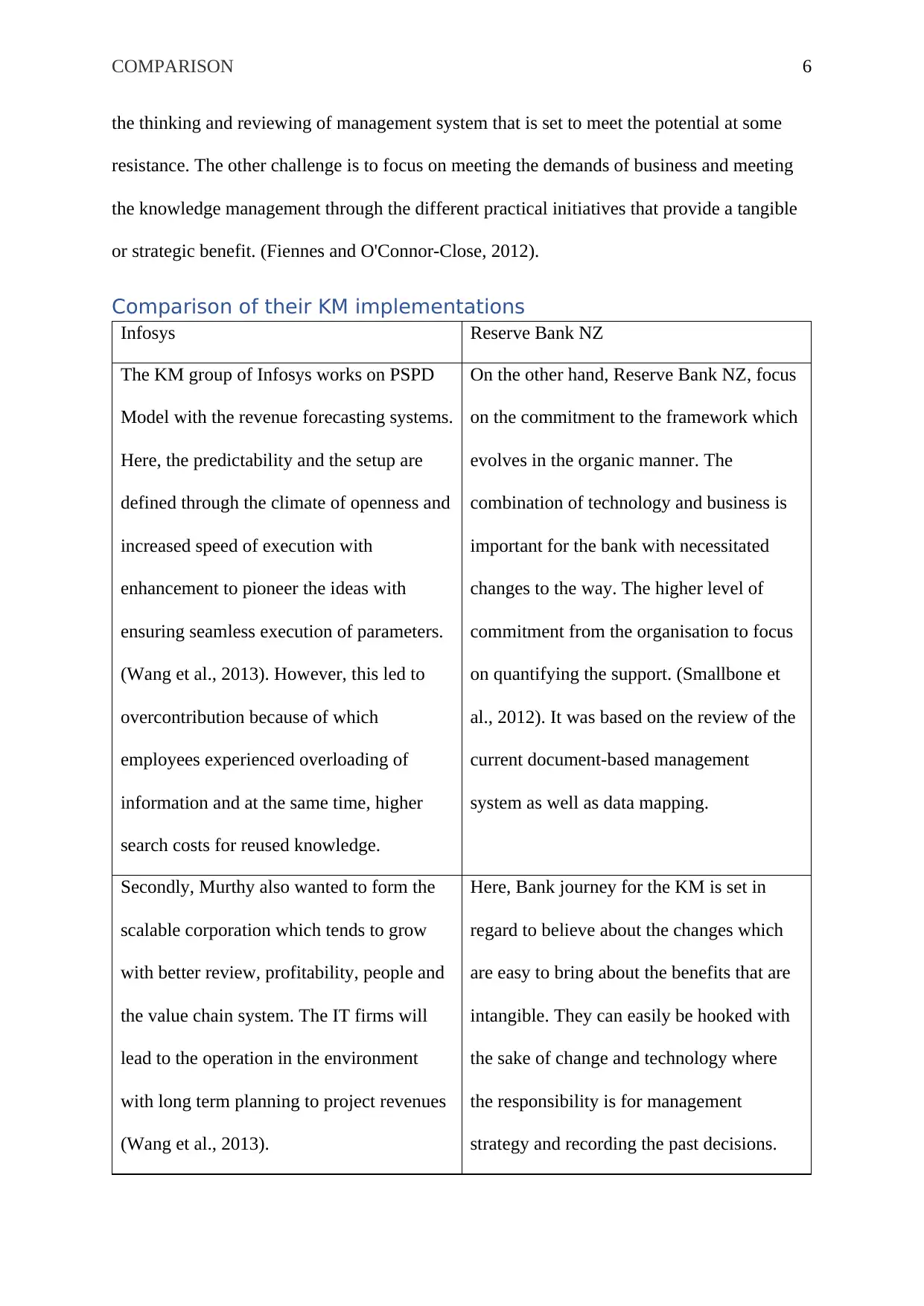
COMPARISON 6
the thinking and reviewing of management system that is set to meet the potential at some
resistance. The other challenge is to focus on meeting the demands of business and meeting
the knowledge management through the different practical initiatives that provide a tangible
or strategic benefit. (Fiennes and O'Connor-Close, 2012).
Comparison of their KM implementations
Infosys Reserve Bank NZ
The KM group of Infosys works on PSPD
Model with the revenue forecasting systems.
Here, the predictability and the setup are
defined through the climate of openness and
increased speed of execution with
enhancement to pioneer the ideas with
ensuring seamless execution of parameters.
(Wang et al., 2013). However, this led to
overcontribution because of which
employees experienced overloading of
information and at the same time, higher
search costs for reused knowledge.
On the other hand, Reserve Bank NZ, focus
on the commitment to the framework which
evolves in the organic manner. The
combination of technology and business is
important for the bank with necessitated
changes to the way. The higher level of
commitment from the organisation to focus
on quantifying the support. (Smallbone et
al., 2012). It was based on the review of the
current document-based management
system as well as data mapping.
Secondly, Murthy also wanted to form the
scalable corporation which tends to grow
with better review, profitability, people and
the value chain system. The IT firms will
lead to the operation in the environment
with long term planning to project revenues
(Wang et al., 2013).
Here, Bank journey for the KM is set in
regard to believe about the changes which
are easy to bring about the benefits that are
intangible. They can easily be hooked with
the sake of change and technology where
the responsibility is for management
strategy and recording the past decisions.
the thinking and reviewing of management system that is set to meet the potential at some
resistance. The other challenge is to focus on meeting the demands of business and meeting
the knowledge management through the different practical initiatives that provide a tangible
or strategic benefit. (Fiennes and O'Connor-Close, 2012).
Comparison of their KM implementations
Infosys Reserve Bank NZ
The KM group of Infosys works on PSPD
Model with the revenue forecasting systems.
Here, the predictability and the setup are
defined through the climate of openness and
increased speed of execution with
enhancement to pioneer the ideas with
ensuring seamless execution of parameters.
(Wang et al., 2013). However, this led to
overcontribution because of which
employees experienced overloading of
information and at the same time, higher
search costs for reused knowledge.
On the other hand, Reserve Bank NZ, focus
on the commitment to the framework which
evolves in the organic manner. The
combination of technology and business is
important for the bank with necessitated
changes to the way. The higher level of
commitment from the organisation to focus
on quantifying the support. (Smallbone et
al., 2012). It was based on the review of the
current document-based management
system as well as data mapping.
Secondly, Murthy also wanted to form the
scalable corporation which tends to grow
with better review, profitability, people and
the value chain system. The IT firms will
lead to the operation in the environment
with long term planning to project revenues
(Wang et al., 2013).
Here, Bank journey for the KM is set in
regard to believe about the changes which
are easy to bring about the benefits that are
intangible. They can easily be hooked with
the sake of change and technology where
the responsibility is for management
strategy and recording the past decisions.
⊘ This is a preview!⊘
Do you want full access?
Subscribe today to unlock all pages.

Trusted by 1+ million students worldwide
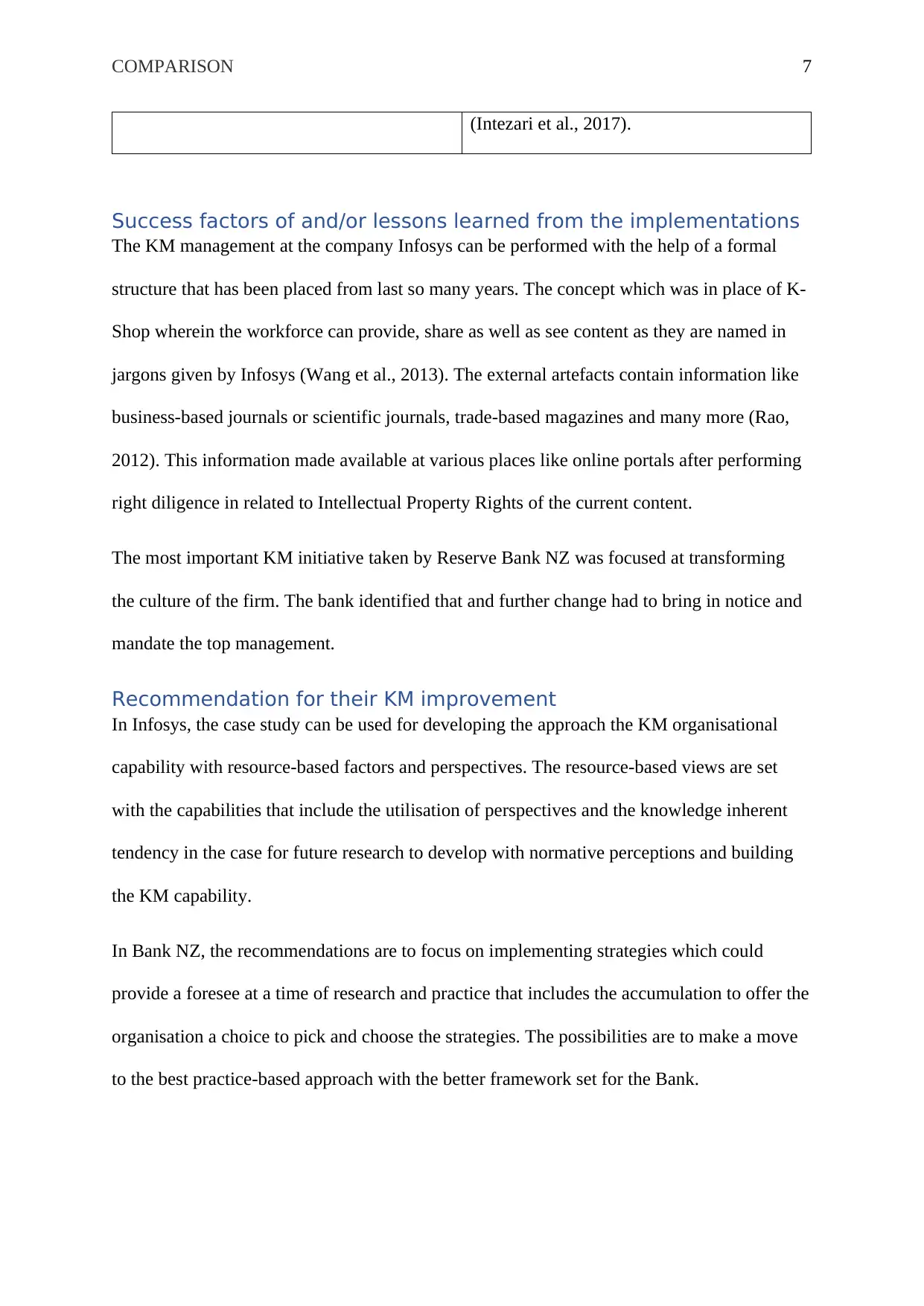
COMPARISON 7
(Intezari et al., 2017).
Success factors of and/or lessons learned from the implementations
The KM management at the company Infosys can be performed with the help of a formal
structure that has been placed from last so many years. The concept which was in place of K-
Shop wherein the workforce can provide, share as well as see content as they are named in
jargons given by Infosys (Wang et al., 2013). The external artefacts contain information like
business-based journals or scientific journals, trade-based magazines and many more (Rao,
2012). This information made available at various places like online portals after performing
right diligence in related to Intellectual Property Rights of the current content.
The most important KM initiative taken by Reserve Bank NZ was focused at transforming
the culture of the firm. The bank identified that and further change had to bring in notice and
mandate the top management.
Recommendation for their KM improvement
In Infosys, the case study can be used for developing the approach the KM organisational
capability with resource-based factors and perspectives. The resource-based views are set
with the capabilities that include the utilisation of perspectives and the knowledge inherent
tendency in the case for future research to develop with normative perceptions and building
the KM capability.
In Bank NZ, the recommendations are to focus on implementing strategies which could
provide a foresee at a time of research and practice that includes the accumulation to offer the
organisation a choice to pick and choose the strategies. The possibilities are to make a move
to the best practice-based approach with the better framework set for the Bank.
(Intezari et al., 2017).
Success factors of and/or lessons learned from the implementations
The KM management at the company Infosys can be performed with the help of a formal
structure that has been placed from last so many years. The concept which was in place of K-
Shop wherein the workforce can provide, share as well as see content as they are named in
jargons given by Infosys (Wang et al., 2013). The external artefacts contain information like
business-based journals or scientific journals, trade-based magazines and many more (Rao,
2012). This information made available at various places like online portals after performing
right diligence in related to Intellectual Property Rights of the current content.
The most important KM initiative taken by Reserve Bank NZ was focused at transforming
the culture of the firm. The bank identified that and further change had to bring in notice and
mandate the top management.
Recommendation for their KM improvement
In Infosys, the case study can be used for developing the approach the KM organisational
capability with resource-based factors and perspectives. The resource-based views are set
with the capabilities that include the utilisation of perspectives and the knowledge inherent
tendency in the case for future research to develop with normative perceptions and building
the KM capability.
In Bank NZ, the recommendations are to focus on implementing strategies which could
provide a foresee at a time of research and practice that includes the accumulation to offer the
organisation a choice to pick and choose the strategies. The possibilities are to make a move
to the best practice-based approach with the better framework set for the Bank.
Paraphrase This Document
Need a fresh take? Get an instant paraphrase of this document with our AI Paraphraser
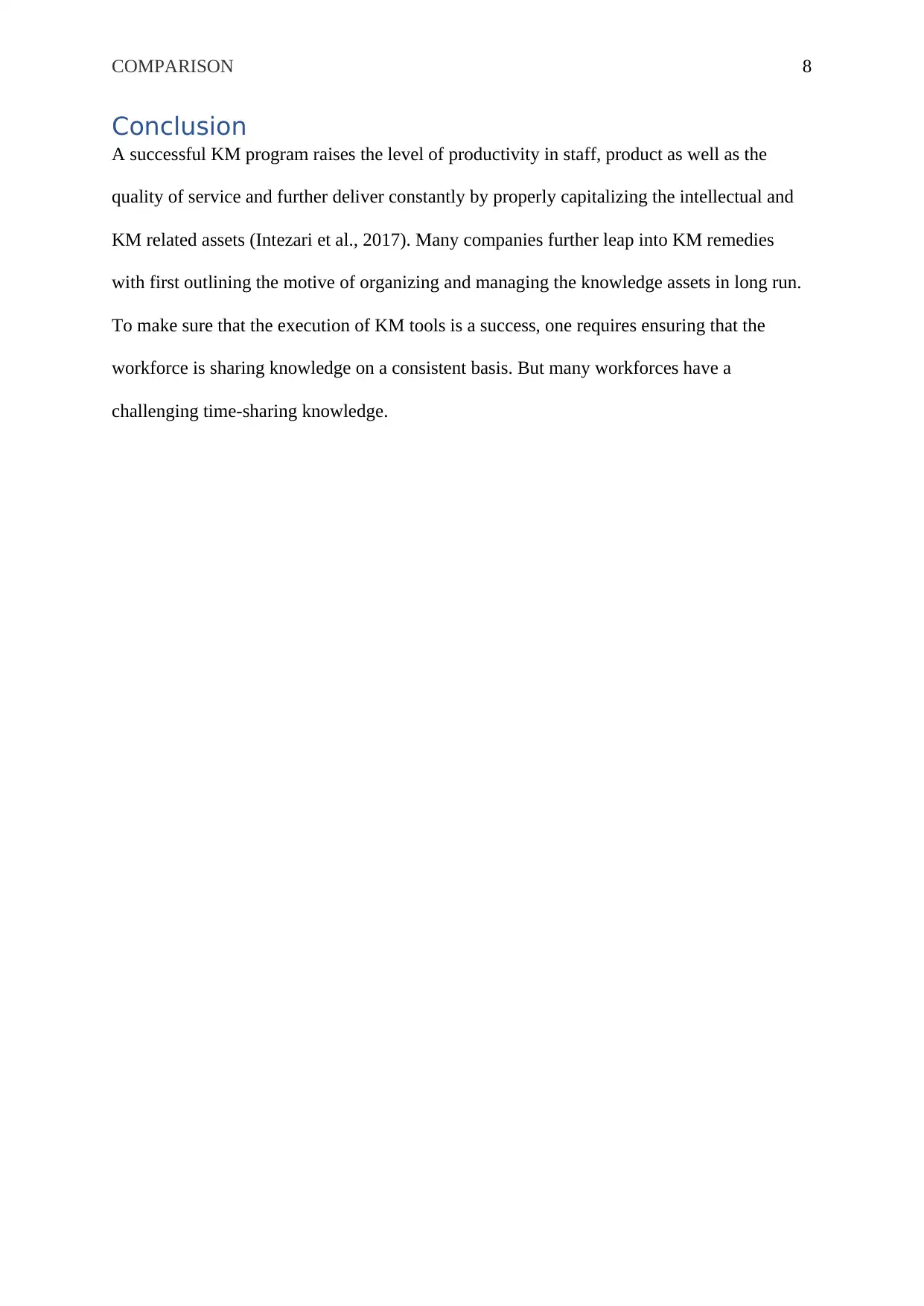
COMPARISON 8
Conclusion
A successful KM program raises the level of productivity in staff, product as well as the
quality of service and further deliver constantly by properly capitalizing the intellectual and
KM related assets (Intezari et al., 2017). Many companies further leap into KM remedies
with first outlining the motive of organizing and managing the knowledge assets in long run.
To make sure that the execution of KM tools is a success, one requires ensuring that the
workforce is sharing knowledge on a consistent basis. But many workforces have a
challenging time-sharing knowledge.
Conclusion
A successful KM program raises the level of productivity in staff, product as well as the
quality of service and further deliver constantly by properly capitalizing the intellectual and
KM related assets (Intezari et al., 2017). Many companies further leap into KM remedies
with first outlining the motive of organizing and managing the knowledge assets in long run.
To make sure that the execution of KM tools is a success, one requires ensuring that the
workforce is sharing knowledge on a consistent basis. But many workforces have a
challenging time-sharing knowledge.
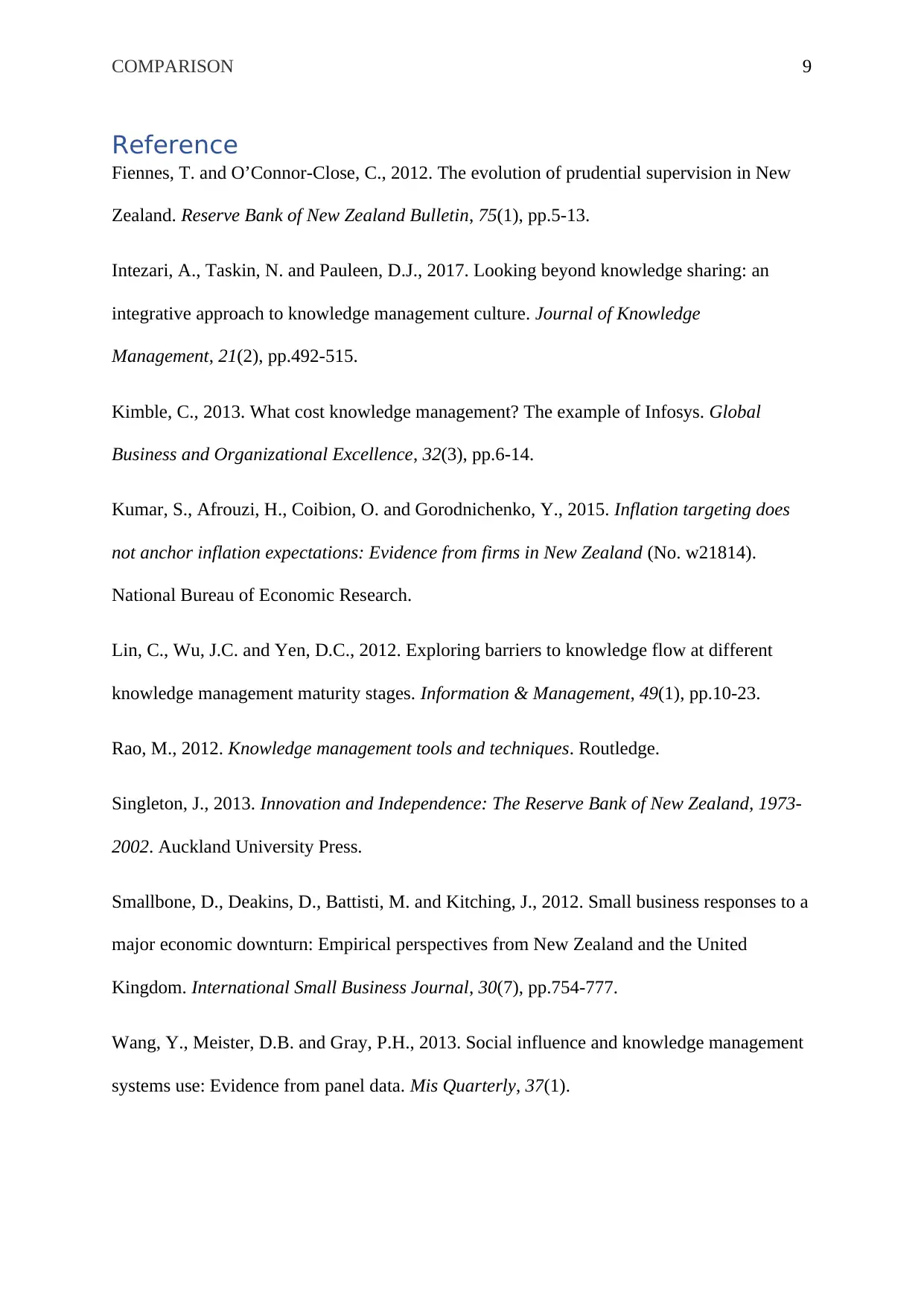
COMPARISON 9
Reference
Fiennes, T. and O’Connor-Close, C., 2012. The evolution of prudential supervision in New
Zealand. Reserve Bank of New Zealand Bulletin, 75(1), pp.5-13.
Intezari, A., Taskin, N. and Pauleen, D.J., 2017. Looking beyond knowledge sharing: an
integrative approach to knowledge management culture. Journal of Knowledge
Management, 21(2), pp.492-515.
Kimble, C., 2013. What cost knowledge management? The example of Infosys. Global
Business and Organizational Excellence, 32(3), pp.6-14.
Kumar, S., Afrouzi, H., Coibion, O. and Gorodnichenko, Y., 2015. Inflation targeting does
not anchor inflation expectations: Evidence from firms in New Zealand (No. w21814).
National Bureau of Economic Research.
Lin, C., Wu, J.C. and Yen, D.C., 2012. Exploring barriers to knowledge flow at different
knowledge management maturity stages. Information & Management, 49(1), pp.10-23.
Rao, M., 2012. Knowledge management tools and techniques. Routledge.
Singleton, J., 2013. Innovation and Independence: The Reserve Bank of New Zealand, 1973-
2002. Auckland University Press.
Smallbone, D., Deakins, D., Battisti, M. and Kitching, J., 2012. Small business responses to a
major economic downturn: Empirical perspectives from New Zealand and the United
Kingdom. International Small Business Journal, 30(7), pp.754-777.
Wang, Y., Meister, D.B. and Gray, P.H., 2013. Social influence and knowledge management
systems use: Evidence from panel data. Mis Quarterly, 37(1).
Reference
Fiennes, T. and O’Connor-Close, C., 2012. The evolution of prudential supervision in New
Zealand. Reserve Bank of New Zealand Bulletin, 75(1), pp.5-13.
Intezari, A., Taskin, N. and Pauleen, D.J., 2017. Looking beyond knowledge sharing: an
integrative approach to knowledge management culture. Journal of Knowledge
Management, 21(2), pp.492-515.
Kimble, C., 2013. What cost knowledge management? The example of Infosys. Global
Business and Organizational Excellence, 32(3), pp.6-14.
Kumar, S., Afrouzi, H., Coibion, O. and Gorodnichenko, Y., 2015. Inflation targeting does
not anchor inflation expectations: Evidence from firms in New Zealand (No. w21814).
National Bureau of Economic Research.
Lin, C., Wu, J.C. and Yen, D.C., 2012. Exploring barriers to knowledge flow at different
knowledge management maturity stages. Information & Management, 49(1), pp.10-23.
Rao, M., 2012. Knowledge management tools and techniques. Routledge.
Singleton, J., 2013. Innovation and Independence: The Reserve Bank of New Zealand, 1973-
2002. Auckland University Press.
Smallbone, D., Deakins, D., Battisti, M. and Kitching, J., 2012. Small business responses to a
major economic downturn: Empirical perspectives from New Zealand and the United
Kingdom. International Small Business Journal, 30(7), pp.754-777.
Wang, Y., Meister, D.B. and Gray, P.H., 2013. Social influence and knowledge management
systems use: Evidence from panel data. Mis Quarterly, 37(1).
⊘ This is a preview!⊘
Do you want full access?
Subscribe today to unlock all pages.

Trusted by 1+ million students worldwide
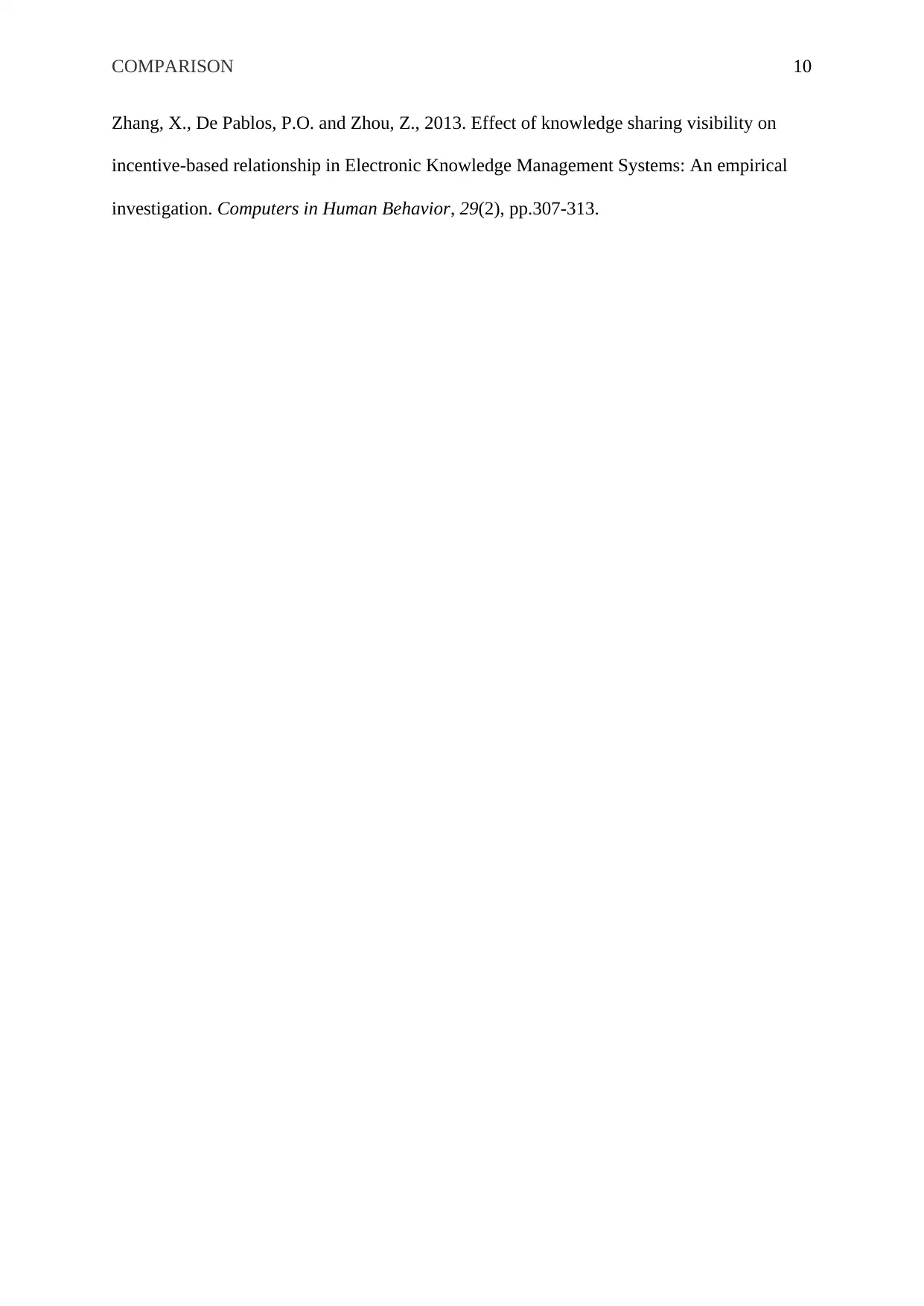
COMPARISON 10
Zhang, X., De Pablos, P.O. and Zhou, Z., 2013. Effect of knowledge sharing visibility on
incentive-based relationship in Electronic Knowledge Management Systems: An empirical
investigation. Computers in Human Behavior, 29(2), pp.307-313.
Zhang, X., De Pablos, P.O. and Zhou, Z., 2013. Effect of knowledge sharing visibility on
incentive-based relationship in Electronic Knowledge Management Systems: An empirical
investigation. Computers in Human Behavior, 29(2), pp.307-313.
1 out of 10
Related Documents
Your All-in-One AI-Powered Toolkit for Academic Success.
+13062052269
info@desklib.com
Available 24*7 on WhatsApp / Email
![[object Object]](/_next/static/media/star-bottom.7253800d.svg)
Unlock your academic potential
Copyright © 2020–2025 A2Z Services. All Rights Reserved. Developed and managed by ZUCOL.





